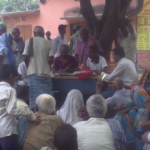Ram Subhagram's polio-stricken father withers in pain as he lies in the sub-health centre in Pranpur, Bihar hoping that a doctor comes to visit him soon and relieves him of the pain. But Ram knows that the wait is indefinite. While Health Ministry guidelines state that a sub-health centre is to be operational 24×7, this centre is occasionally open for a few days a month, since 20 years. However, Ram has no other option but to wait for the centre to open to get treatment for his father because poverty makes it impossible for him to seek private medical assistance.
Frustrated by the inactive health centre, the residents have decided to use the abandoned space, "The Pranpur residents have started using the abandoned space as a storing place for fodder and the occasional shack for travelling relatives and friends," reveals Community Correspondent Surendra, who lives in the neighbouring village of Madanpur. The centre's doors have a perpetual lock, but the unfinished buildings have no windows, which serve as a doorway into the buildings.
"On the rare occasion that the health centre is open, the nurse tells us that the centre has no medicines," tells a frustrated Ram. The Ministry of Health and Family Welfare meets the expenses of the drug and equipment supply, and also of the female health worker and the Auxiliary Nurse Midwife in addition to the contingency fund.
The question remains that if the health centre is occasionally functional, are the salaries and other funds for the centre allocated for the entire year, being misused?
The women of Pranpur reveal how not having a sub-health centre in the village affects the mothers and children. "The nearest hospital is 5-6 km away in Madanpur. Taking a heavily pregnant woman through bad roads poses a lot of threat to her life. We are unable to meet the rental expenses of the vehicle which cost Rs. 500, not do we get a loan for the same easily," Brideshini Devi explains Surendra. The sub-health centre is instrumental in keeping track of maternal and child health, including nutrition, immunisation, diarrhoea, etc.
Bihar's maternal mortality rate (MMR) is the third-highest in the country at 219, as compared to India's MMR of 178. The state also has 6.6 million chronically malnourished children, the second highest number of malnourished children in India.
A report by Jan Swasthya Abhiyan, the Indian circle of the People's Health Movement reveals that a Bihari citizen's average out-of-pocket expenditure was Rs 41,00, which was mostly spent on drugs and diagnostics.
BPL families who are unable to finance these expenses, take loans or sell familial properties, slipping further into the black hole of poverty, they aspire to get out of.
The Rural Health Statistics 2015 reveals the inadequancy of rural health infrastructure of Bihar. According to the report, one health sub-centre in Bihar caters to over 9,000 people (against the norm of 1000), PHC caters to 50,000 people (against the norm of 30,000) and one community health centre caters to 13 lakh people (against the norm of 1.2 lakh).
Like Ram and Brideshni, there are several hundred Below Poverty Line (BPL) families in the village of Pranpur who suffer due to a non-functional health centre. Please call the Medical officer of Madanpur, Bihar, Naval Kishor on +91-9470003053 to look into the state of affairs at the sub-health centre and ensure that it is functional 24×7.
This video was made by a Video Volunteers Community Correspondent Surendra Sharma.
Fighting for Change: The Story of Bihar-Based Journalist Amir Abbas
Inspiration can come from many sources, but one of the most powerful is seeing someone walk the path before you. Our Community Correspondent, Syed Amir Abbas found his inspiration in Stalin K., the founding director of Video Volunteers. “I met Stalin at VV’s national meet in 2017 and I...
A bridge about to collapse in Bihar
The bridge that was built by the British is slowly chipping off, and fatal accidents are a regular occurrence there. The villagers along with our Community Correspondent are requesting the Government officials to repair this bridge. They are getting assurance that the repair work will start soon though it...

